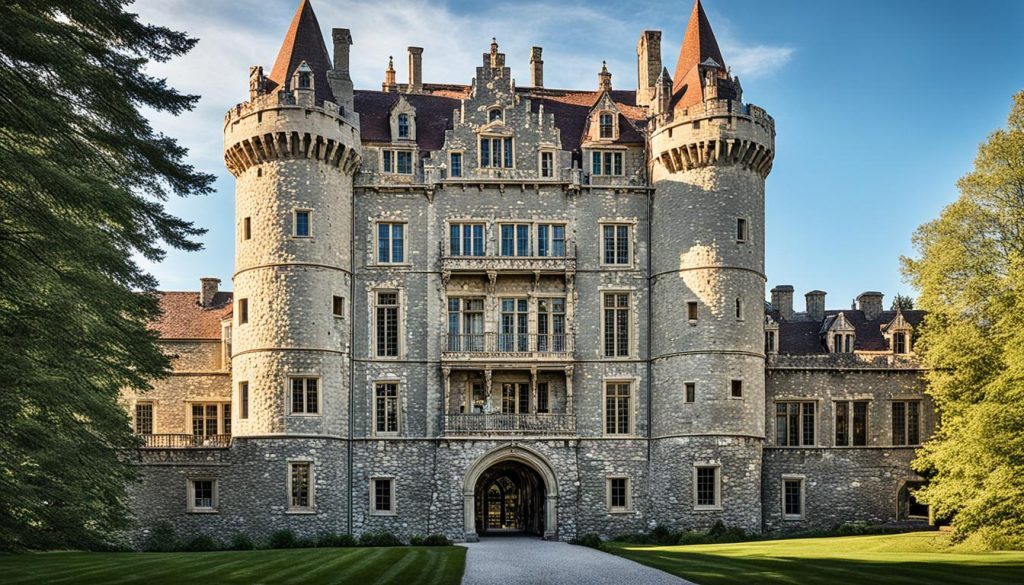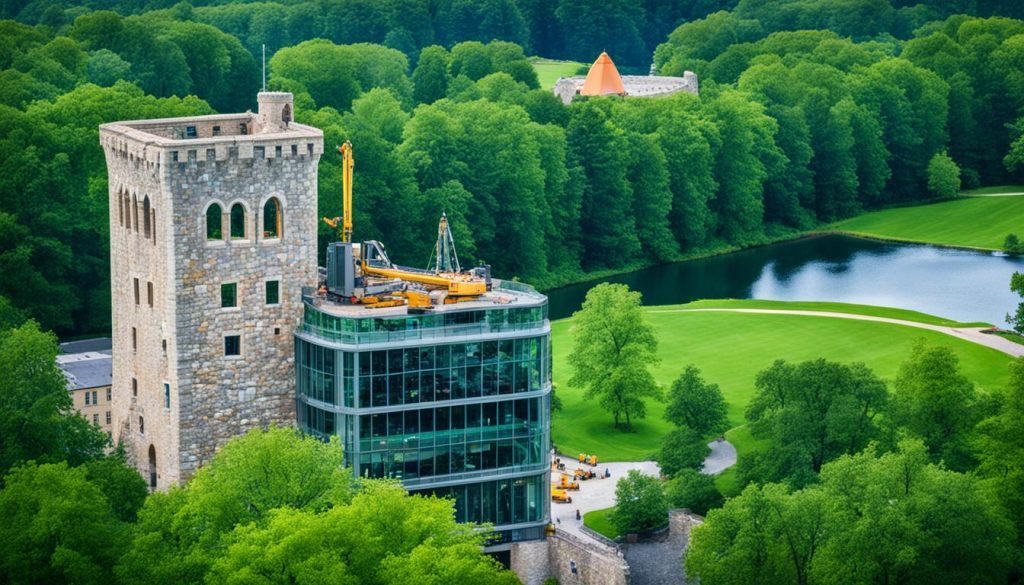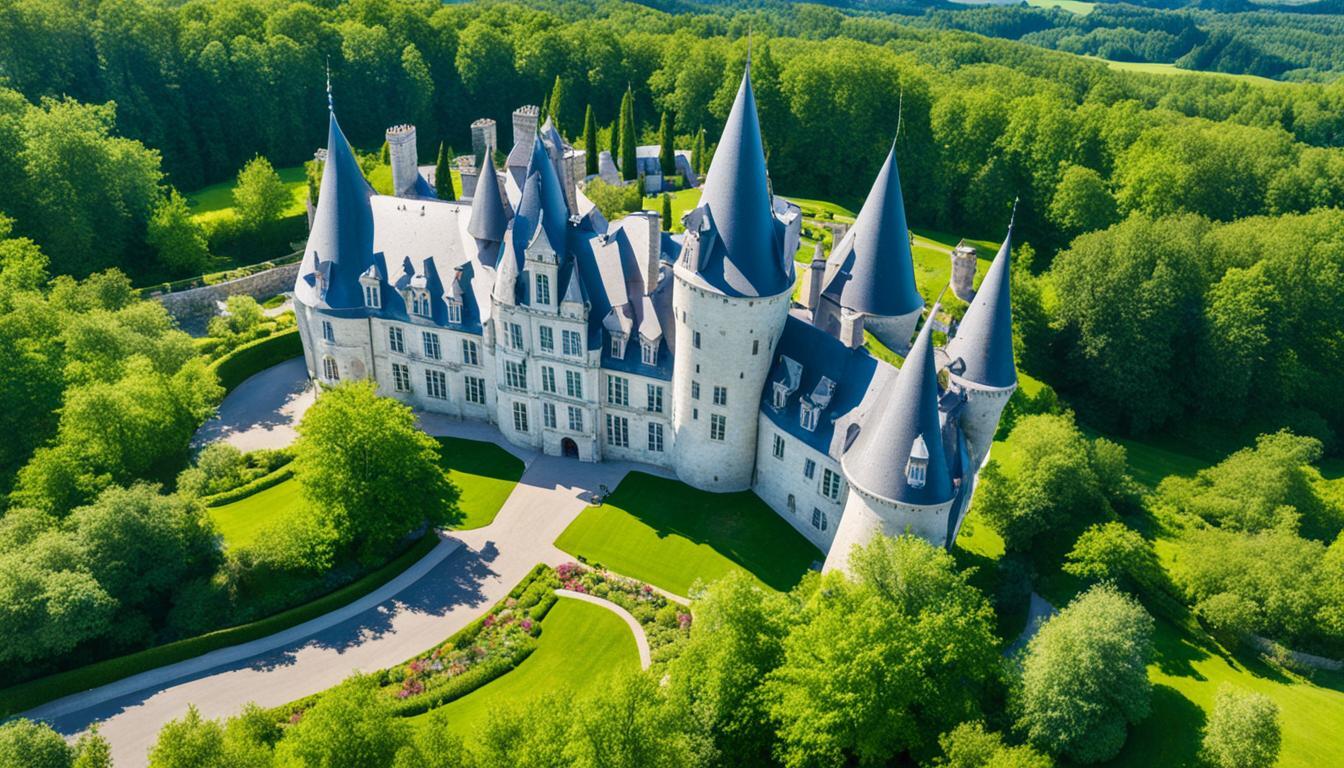Did you know that chateaus hold a rich history dating back centuries and are considered some of the most luxurious and historic properties in the world? If you’re lucky enough to own a chateau or have the opportunity to restore one, you’re embarking on a remarkable journey of preservation and transformation. But where do you begin? How do you navigate the complexities of chateau renovation while preserving its historical significance?
In this comprehensive guide, I will provide you with step-by-step tips on how to renovate a chateau and achieve a magnificent restoration without breaking the bank. From assessing the scope of the project to budgeting basics, preservation techniques, and hiring the right experts, you’ll learn all the essential strategies to create a harmonious blend of modernity and history in your luxury chateau restoration.
Key Takeaways:
- Chateaus are historic properties with rich cultural significance.
- Transforming a chateau requires a strategic approach and creativity.
- Assessing the scope and prioritizing areas for renovation is essential.
- Create a realistic budget and identify cost-saving opportunities.
- Historical preservation is crucial to honor the chateau’s significance.
Assessing the Scope
The first step in chateau restoration is understanding the restoration needs by assessing the scope of the project. This involves conducting a comprehensive assessment of the chateau’s condition, including the structural integrity and the state of essential systems such as plumbing and electrical wiring. By thoroughly examining the chateau, I can determine the areas that require renovation and prioritize them accordingly.
Understanding the restoration needs allows me to prioritize areas for renovation based on their importance and urgency. I categorize them as essential, recommended, or optional, depending on their significance for the overall restoration project. This approach helps me create a timeline that aligns with the budget and priorities of the project, ensuring a smooth and efficient renovation process.
As seen in the image above, it’s crucial to examine both the exterior and interior of the chateau during the assessment. This includes evaluating the condition of the roof, walls, foundations, windows, and doors, as well as ensuring the proper functioning of essential systems such as heating, cooling, plumbing, and electrical. Identifying areas that require immediate attention and areas that can be addressed later allows for effective planning and resource allocation.
By prioritizing areas for renovation based on their importance and urgency, I can ensure that the restoration process is carried out efficiently and within the set budget. This approach allows me to focus on critical elements first and gradually work towards the overall improvement of the chateau. Understanding the restoration needs and assessing the scope sets the foundation for a successful chateau restoration project.
Budgeting Basics
Creating a realistic renovation budget is an essential step in ensuring the success of your chateau restoration project. By carefully planning and researching costs, you can avoid overspending and identify cost-saving opportunities. Here are some tips to help you create a budget that works for your project:
1. Research and Estimates
To accurately budget for your chateau renovation, it’s important to conduct thorough research and gather estimates from professionals. Reach out to contractors, architects, and suppliers to get an idea of the costs involved in different aspects of the project. Consider factors such as materials, labor, permits, and any additional services that may be required.
2. Contingency Fund
When creating your budget, be sure to include a contingency fund to account for unexpected expenses. Renovation projects often come with surprises, such as hidden damage or unforeseen issues that need to be addressed. Setting aside a portion of your budget for unforeseen costs will help you avoid financial stress and keep your project on track.
3. Identifying Cost-Saving Opportunities
Throughout the renovation process, there are several ways to identify cost-saving opportunities. Consider using alternative materials that are more budget-friendly without compromising quality. Keep an eye out for discounts and sales from suppliers, and consider making bulk purchases to reduce costs. Additionally, think about taking on some DIY projects or engaging volunteers to help with certain tasks, which can save on labor expenses.
| Cost-Saving Tips | Impact on Budget |
|---|---|
| Using alternative materials | Significant cost reduction |
| Utilizing discounts and sales | Moderate cost reduction |
| Making bulk purchases | Moderate cost reduction |
| Incorporating DIY and volunteer work | Significant cost reduction |
By following these budgeting basics and exploring cost-saving opportunities, you can create a realistic renovation budget and ensure that your chateau restoration project stays within financial expectations.
Historical Preservation in Castle Renovation
Historical preservation plays a vital role in castle renovation, as it protects our cultural heritage and ensures the preservation of the castle’s historical significance. It goes beyond mere restoration, offering a deeper understanding of the castle’s rich history and the stories it holds within its walls.
When renovating a castle, it is important to consider the historical significance of the structure and its role in the local community. By preserving the castle’s historical elements, we honor the past and create a bridge between generations, fostering a sense of connection and cultural continuity.
To illustrate the importance of historical preservation, let’s delve into a few examples of castles that have undergone successful renovations while maintaining their historical significance:
- Inveraray Castle in Scotland, which was restored with meticulous attention to detail, preserving its 18th-century Georgian architecture while introducing modern facilities that blend seamlessly with the castle’s historical ambiance.
- Neuschwanstein Castle in Germany, a magnificent fairytale-like structure that has been meticulously preserved to showcase its original grandeur, attracting millions of visitors annually to admire its unique architectural and historical value.
- Château de Versailles in France, a UNESCO World Heritage site, where careful preservation efforts have allowed visitors to step back in time and experience the opulence and grandeur of the French monarchy.
Understanding the historical significance of a castle is crucial during the renovation process. It involves researching the castle’s history, uncovering its architectural style, and identifying key features, such as original stonework, intricate wood carvings, or historical artifacts that must be preserved.
By embracing historical preservation in castle renovation, we not only breathe new life into these remarkable structures but also ensure that future generations can appreciate and learn from our shared heritage.

Planning the Renovation to Balance Modernity and History
When embarking on the renovation of a historic castle, it is important to strike the right balance between preserving its historical charm and incorporating modern elements. To achieve this delicate equilibrium, a thoughtful and strategic approach is necessary. Here are my tips for planning the renovation while honoring the castle’s cultural significance:
- Understand the Castle’s History: Begin by researching the castle’s history to gain a deeper understanding of its architectural style, key features, and cultural importance. This knowledge will guide your renovation decisions and help you identify elements that must be preserved to maintain the castle’s historical integrity.
- Identify Key Features to Preserve: Collaborate with architects, historians, and preservation experts to identify the key features of the castle that hold historical value. These could include intricate woodwork, original stained glass windows, or unique frescoes. By prioritizing the preservation of these elements, you can ensure that the castle’s historical character remains intact.
- Hire the Right Experts: Bringing together a team of professionals who specialize in historic renovations is crucial. Look for architects, interior designers, and contractors with experience in balancing modernity and history in their projects. Their expertise will be invaluable in guiding the renovation process and making informed choices that respect the castle’s cultural significance.
To further illustrate the importance of planning the renovation to balance modernity and history, take a look at this example:

As shown in the image above, this restored castle seamlessly blends modern design elements with its historic architecture. The contemporary furnishings and sleek finishes complement the grandeur of the castle while preserving its cultural heritage. By planning the renovation with careful consideration for both modernity and history, a harmonious and enchanting living space can be created.
| Advantages of Planning the Renovation | Challenges of Balancing Modernity and History |
|---|---|
| Preserves the castle’s cultural significance | Ensuring compatibility between modern and historical elements |
| Creates a unique and captivating living space | Identifying the right design choices to strike a balance |
| Enhances the castle’s market value | Managing the complexities of integrating modern amenities |
The table above highlights the advantages of planning the renovation to balance modernity and history, as well as the challenges that may arise in the process. By adopting a strategic approach and hiring the right experts, these challenges can be navigated effectively.
Key Tips for Historical Preservation in Castle Renovation
When embarking on a castle renovation project, historical preservation should be a top priority. By following these key tips, you can ensure that the historical significance of your castle is preserved while creating a comfortable living space for modern-day residents.
Researching the castle’s history is the first crucial step. Understand the events, architectural styles, and cultural influences that shaped the castle to make informed restoration decisions. Take note of any unique features or historical elements that need to be protected and incorporated into the renovation.
Identifying key features to preserve is essential to maintain the castle’s authenticity. Whether it’s a grand staircase, ornate ceilings, or original artwork, these elements contribute to the castle’s charm and character. Make a list of these features and prioritize their restoration during the renovation process.
Planning the renovation is where the real magic happens. Balancing modernity and history requires careful consideration. Consult with experts who specialize in castle restorations to help you navigate this delicate balance. Their expertise and industry knowledge will be invaluable in preserving the castle’s historical integrity while incorporating modern amenities.
Hiring the right experts is crucial for a successful castle renovation project. Look for professionals who have experience in historical preservation, architecture, and construction. Seek referrals, review portfolios, and conduct interviews to ensure that you hire the best team for the job. Their expertise will guide the renovation process and ensure that your castle is restored to its former glory.

Leave a Reply Cancel reply
You must be logged in to post a comment.